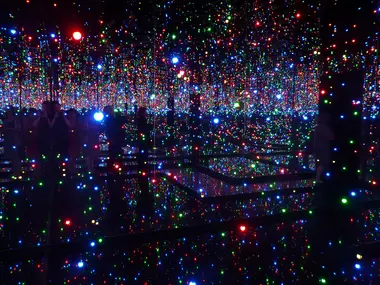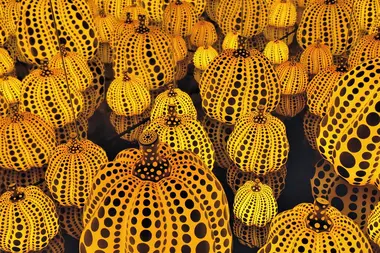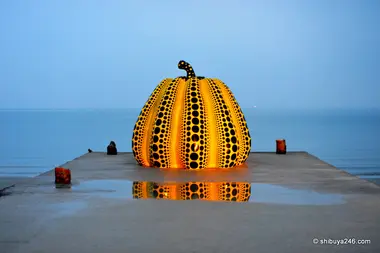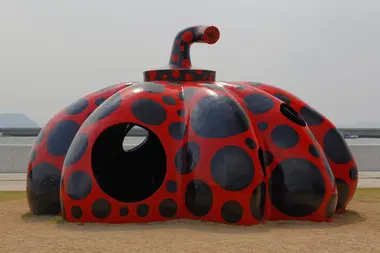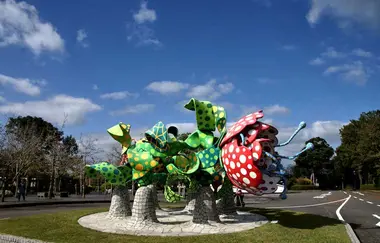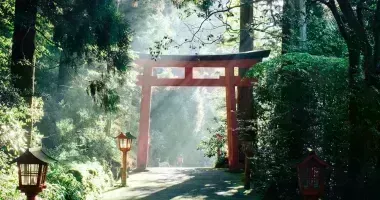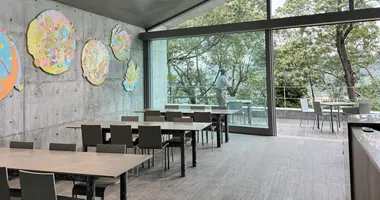Where can you see Yayoi Kusama's work in Japan?
- Published on : 04/03/2025
- by : Marion. E
- Youtube
Japanese contemporary artist Yayoi Kusama, now 94, has become a leading figure in contemporary art worldwide. Renowned for her immersive installations, obsessive polka-dot motifs and famous giant pumpkins, she fascinates with a unique artistic universe born of her hallucinations. For art lovers traveling to Japan, discovering her emblematic works scattered across the archipelago is a singular experience. From Tokyo to Naoshima, via Matsumoto, her hometown, the creations of this nonagenarian artist are exhibited in various museums and public spaces, inviting visitors to plunge into a colorful, hypnotic world.
The Yayoi Kusama Museum in Tokyo: a temple to the artist
Inaugurated in October 2017 in Tokyo's Shinjuku district, the Yayoi Kusama Museum is the perfect setting to discover the artist's protean work. Designed by architect Kume Sekkei, this five-storey white building with curved walls offers an immersive experience into Kusama's world. Visitors are led upwards along a staircase that seems to float along the rounded walls.
Among the museum's flagship installations, theInfinity Mirrored Room is undoubtedly the most emblematic. This room, entirely covered in mirrors, creates an illusion of infinity, with a series of twinkling lights reflected ad infinitum. The experience, limited to two minutes with the watch in hand and a maximum of six people, provokes a feeling of perfect tranquillity and total immersion. The Pumpkin Room, another major installation, features walls, floors and ceilings covered in red and yellow pumpkin motifs, while resin pumpkin sculptures of various sizes are arranged throughout the room.
On the terrace on the top level, an enormous golden pumpkin with pink polka dots sits proudly, offering a striking spectacle and a nod to one of the artist's best-known motifs. The temporary exhibitions are renewed twice a year, so each visit offers a new perspective on Kusama's work, from the beginning of her career to her latest creations.
Visits to the museum must be booked in advance on the official website, as tickets are not sold on site. Tickets go on sale on the first day of each month for the following month, and give access to a specific 90-minute time slot. Admission is 1100 yen for adults and 600 yen for children aged 6 to 18.
Address: 107 Bentencho Shinjuku-ku Tokyo 162-0851 Japan
Website: https: //yayoikusamamuseum.jp/en/about/museum/
Naoshima's iconic pumpkin and island art installations
On the artistic island of Naoshima, in the Seto Inland Sea, stands probably Yayoi Kusama's most iconic work: the famous yellow pumpkin with black polka dots installed on a pontoon by the sea. This monumental sculpture has become the very symbol of an island dedicated to contemporary art. Seriously damaged by a typhoon in the summer of 2023, it was restored and reinstalled in the autumn of the same year, much to the delight of visitors.
At Miyanoura harbor, visitors are also greeted by another pumpkin, this time a red one, also by Kusama. These giant pumpkins, which are freely accessible, have become major tourist attractions, attracting visitors from all over the world.
Pumpkins are a recurring theme in Kusama's art, symbolizing obsession and singularity, but also nature and organic life. For the artist, these round, comforting shapes evoke childhood and innocence, while carrying a spiritual dimension specific to Japanese culture.
The island of Naoshima thus offers a unique encounter between art, nature and architecture. The Chichu Art Museum and Benesse House Museum, designed by world-renowned architect Tadao Ando, also house works by Kusama and other contemporary artists.
To reach Naoshima, you need to take a ferry from the port of Takamatsu, which takes around an hour. The island, with its lush nature and numerous restaurants serving fresh fish from the Seto Inland Sea, is well worth a full day's exploration.
Address: Naoshima, Kagawa District, Kagawa 761-3110, Japan
Website: https: //naoshima.net/en/
Kusama's works at the art museum in her hometown of Matsumoto
Matsumoto, Yayoi Kusama's hometown in Nagano Prefecture, is home to the Matsumoto City Museum of Art, which features a major permanent collection of the artist's work. Born into a well-to-do family in 1929, Kusama spent her childhood here, and it was here that her first hallucinations, which were to influence all her work, manifested themselves.
Upon entering the museum, built in 2002, visitors are greeted by a monumental installation entitled "Flowers That Bloom at Midnight". This outdoor work features giant flowers, around 1 to 2 metres high, with petals adorned with colourful dots. Their disproportionate scale and vivid colors evoke science-fiction alien flora, while reflecting the artist's abundant imagination.
Inside the museum, a room is dedicated to "Infinity Nets", a series of abstract paintings composed of repetitive patterns of meshes, circles, dots or lines densely painted and covering the entire surface of the canvas. These works, often monochromatic, create a hypnotic effect of movement and depth. For Kusama, these infinite networks represent an attempt to lose oneself in immensity, to transcend the limits of physical reality.
The museum also exhibits works from different periods of the artist's career, from his earliest works to his most recent creations. Paintings, sculptures and installations testify to the evolution of his style and artistic preoccupations.
A visit to the Matsumoto Museum is an essential step towards understanding the origins and evolution of Yayoi Kusama's unique artistic work. Located a 15-minute walk from Matsumoto station, it is easily accessible from Tokyo (2h30 by train) or Nagoya (2h by train). Admission costs 410 yen.
Address: 4 Chome-2-22 Central, Matsumoto, Nagano 390-0811, Japan
Website: http: //matsumoto-artmuse.jp/en/
Infinity Rooms and Infinity Nets: where to discover mirror installations and infinite paintings
The Infinity Rooms are undoubtedly Yayoi Kusama's most captivating and photographed works. These immersive installations, in which the artist began working in the 1960s, are enclosed spaces entirely covered with mirrors and repetitive patterns that create a dizzying illusion of infinity. Visitors enter to enjoy a unique sensory experience in which series of flashing lights and objects are reflected ad infinitum.
At Tokyo's Yayoi Kusama Museum, the "Infinity Mirrored Room" installation is one of the main attractions. In these spaces, our notions of space and temporality are completely overturned. We can no longer perceive outside sounds, and the mirror-covered walls, floors and ceilings create a sensation of vertigo and immensity. Everywhere, tiny lights twinkle like stars lost in the cosmos. For the artist, these points of light represent souls or fairies sailing through the universe.
The Infinity Nets are a series of abstract paintings that can be admired at the Matsumoto Art Museum and the Fukuoka Art Museum. These monochromatic canvases are covered with small, repetitive circles that create a sensation of infinite depth. For Kusama, these networks represent "an attempt to prophetically measure the infinity of the immeasurable universe", and she describes them as "a point in the middle of those millions of particles that are peas".
The Pola Art Museum in Hakone presents the exhibition "Bed, Dots Obsession", featuring iconic works by Kusama, including her bed-shaped sculpture and obsessive dot motifs. This exhibition allows visitors to explore the evolution of the artist's career, from her early figurative paintings to her contemporary installations, always marked by these space-invading dots.
These works, which play with our perception and relationship to space, are deeply linked to the obsessive disorders and hallucinations from which the artist has suffered since childhood. Kusama has succeeded in transforming these disturbing experiences into a totally unique and universally accessible art form.
Floral installations and monumental outdoor sculptures
Beyond museums, Yayoi Kusama's monumental works also flourish outdoors across Japan, offering visitors an immersive artistic experience in the heart of nature. These installations, often large-scale and brightly colored, create a striking dialogue between art and the natural environment.
One of the most remarkable floral installations can be found at the Open-Air Museum in Kirishima, Kagoshima Prefecture. Flowers of Shangri-la" evokes an imaginary land where flowers of billions of colors bloom. For the artist, these monumental floral sculptures represent life, soul and hope. Through these creations, Kusama invites viewers to reconnect with their innocence and childhood, immersing them in a dreamlike universe. This permanent installation, displayed in a peaceful, natural setting, can be admired for the modest price of 320 yen.
On the terrace of Tokyo's Yayoi Kusama Museum, a huge, brightly-colored flower greets visitors, offering a lovely nod to the artist's favorite theme. This monumental sculpture, visible from the top floor of the museum, is in dialogue with the surrounding urban landscape and provides a colorful landmark in the neighborhood.
As part of the Echigo-Tsumari Contemporary Art Triennial in Niigata prefecture, Kusama's installations were also presented outdoors, temporarily transforming the Japanese rural landscape into an open-air art gallery.
These outdoor works testify to Kusama's ability to transcend traditional exhibition spaces to create total artistic experiences, where the boundaries between art and everyday life become blurred. Whether through her giant pumpkins, monumental flowers or immersive installations, the artist invites the public to physically enter her disturbing and enchanting mental universe.
Kirishima Open-Air Museum address: 220 Koba 6340, Yusui-cho, Aira-gun, Kagoshima, Kyūshū
Website: https: //open-air-museum.org/en/
Japanese contemporary art museums exhibiting Kusama's work
In addition to the institutions already mentioned, many contemporary art museums across Japan present permanent collections or temporary exhibitions dedicated to Yayoi Kusama. These venues offer the opportunity to discover different facets of her prolific oeuvre.
The Fukuoka Art Museum, in southern Japan, boasts an extensive collection of Kusama's work, mainly paintings, but also a number of sculptures and installations. The collection includes works that reflect the artist's commitment to peace and universal love. Visitors can admire his famous "Infinity Net" series, canvases covered with small circles that create a sensation of infinite depth. For just 200 yen, this permanent collection offers a comprehensive overview of Kusama's work and its importance in the contemporary art world.
Other major institutions regularly exhibiting works by Kusama include:
- MOMAT (National Museum of Modern Art), Tokyo
- Kyoto National Museum of Modern Art
- Osaka National Museum of Art
- Hara Museum of Contemporary Art, Tokyo
- MOT (Museum of Contemporary Art), Tokyo
- Mori Art Museum, Tokyo
- Chiba City Museum of Fine Arts
- Hiroshima Museum of Contemporary Art
These museums present a variety of Kusama's works, spanning her entire career, from her earliest figurative works to her most emblematic contemporary installations. They enable visitors to understand the evolution of her style and the recurring themes that run through her work: obsession, infinity, nature, repetition, self-obliteration and the spiritual quest.
The Pola Art Museum in Hakone also deserves a special mention for its "Bed, Dots Obsession" exhibition, which explores the evolution of the artist's career in an exceptional natural setting. For 1,800 yen, visitors can admire Kusama's characteristic polka-dot motifs in an immersive, dreamlike atmosphere.
Fukuoka Art Museum address: 1-6 Ohori Koen, Chuo-ku, Fukuoka city, Fukuoka prefecture, 810-0051 Japan
Website: https: //www.fukuoka-art-museum.jp/en/
Address of the Pola Art Museum in Hakone: 1285 Kozukayama, Sengokuhara, Hakone-machi Ashigarashimo-gun, Kanagawa Prefecture, 250-0631 Japan
Website : https://www.polamuseum.or.jp/en/
Practical tips for visiting the Kusama exhibitions in Japan
To make the most of your discovery of Yayoi Kusama's works in Japan, here are a few practical tips to help you plan your artistic itinerary.
First of all, for the Yayoi Kusama Museum in Tokyo, reservations are imperative and must be made well in advance. Tickets go on sale on the first day of each month at 10 a.m. (Japanese time) for the following month. For example, tickets for May go on sale on March 1. Given the museum's popularity, we strongly recommend that you book as soon as the ticket office opens. Please note that no tickets are sold on site, and only online reservations via the museum's official website are possible.
For the Naoshima pumpkin tour, ideally plan a full day to explore the island. Ferries depart regularly from Takamatsu harbor, and the crossing takes about an hour. Check timetables in advance, especially if you want to make the round trip during the day. As the island is small, it can easily be explored on foot or by bicycle (available for hire).
The Matsumoto Art Museum is easily accessible from Tokyo (2h30 by train on the Chuo Line-Limited Express) or Nagoya (2h by train on the JR Shinano Express). It's a 15-minute walk from Matsumoto station. Take advantage of your visit to discover the nearby Matsumoto Castle, one of the most beautiful in Japan.
For Infinity Rooms, please note that due to their popularity, the time spent inside is generally limited (often 2 minutes). So be prepared for an intense but brief experience, and be prepared to queue, especially in museums that don't operate on reservation.
Finally, plan your itinerary according to geography. If you're short on time, concentrate on Tokyo, which is home to several museums exhibiting Kusama's work. For a more complete experience, consider a tour that includes Tokyo, Hakone (for the Pola museum), Matsumoto and Naoshima. This tour will enable you to discover different facets of the artist's work, from paintings to monumental outdoor installations.
Bear in mind that photography is often restricted or prohibited in certain parts of the exhibitions, notably the Infinity Rooms. Find out in advance about each museum's photo policy to avoid disappointment.

